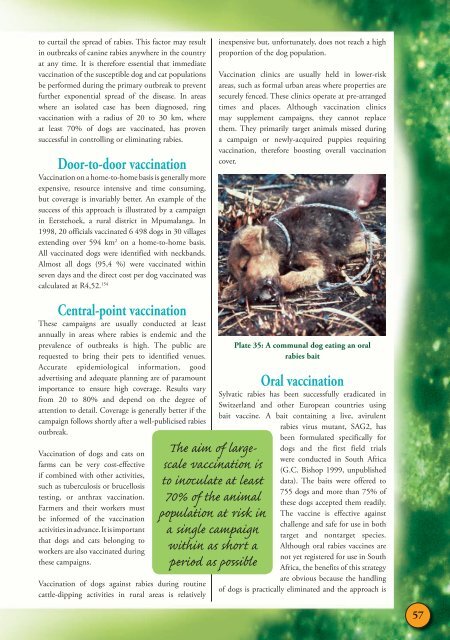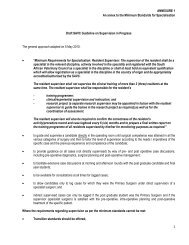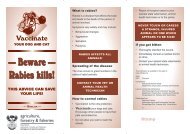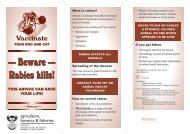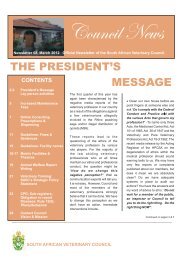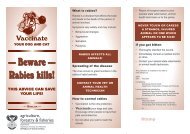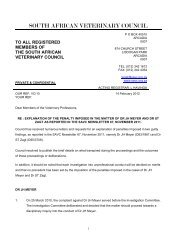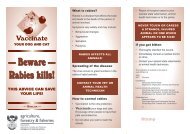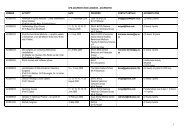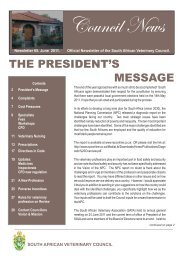Rabies Guide 2010.pdf - the South African Veterinary Council
Rabies Guide 2010.pdf - the South African Veterinary Council
Rabies Guide 2010.pdf - the South African Veterinary Council
Create successful ePaper yourself
Turn your PDF publications into a flip-book with our unique Google optimized e-Paper software.
to curtail <strong>the</strong> spread of rabies. This factor may result<br />
in outbreaks of canine rabies anywhere in <strong>the</strong> country<br />
at any time. It is <strong>the</strong>refore essential that immediate<br />
vaccination of <strong>the</strong> susceptible dog and cat populations<br />
be performed during <strong>the</strong> primary outbreak to prevent<br />
fur<strong>the</strong>r exponential spread of <strong>the</strong> disease. In areas<br />
where an isolated case has been diagnosed, ring<br />
vaccination with a radius of 20 to 30 km, where<br />
at least 70% of dogs are vaccinated, has proven<br />
successful in controlling or eliminating rabies.<br />
Door-to-door vaccination<br />
Vaccination on a home-to-home basis is generally more<br />
expensive, resource intensive and time consuming,<br />
but coverage is invariably better. An example of <strong>the</strong><br />
success of this approach is illustrated by a campaign<br />
in Eerstehoek, a rural district in Mpumalanga. In<br />
1998, 20 officials vaccinated 6 498 dogs in 30 villages<br />
extending over 594 km 2 on a home-to-home basis.<br />
All vaccinated dogs were identified with neckbands.<br />
Almost all dogs (95,4 %) were vaccinated within<br />
seven days and <strong>the</strong> direct cost per dog vaccinated was<br />
calculated at R4,52. 154<br />
Central-point vaccination<br />
These campaigns are usually conducted at least<br />
annually in areas where rabies is endemic and <strong>the</strong><br />
prevalence of outbreaks is high. The public are<br />
requested to bring <strong>the</strong>ir pets to identified venues.<br />
Accurate epidemiological information, good<br />
advertising and adequate planning are of paramount<br />
importance to ensure high coverage. Results vary<br />
from 20 to 80% and depend on <strong>the</strong> degree of<br />
attention to detail. Coverage is generally better if <strong>the</strong><br />
campaign follows shortly after a well-publicised rabies<br />
outbreak.<br />
Vaccination of dogs and cats on<br />
farms can be very cost-effective<br />
if combined with o<strong>the</strong>r activities,<br />
such as tuberculosis or brucellosis<br />
testing, or anthrax vaccination.<br />
Farmers and <strong>the</strong>ir workers must<br />
be informed of <strong>the</strong> vaccination<br />
activities in advance. It is important<br />
that dogs and cats belonging to<br />
workers are also vaccinated during<br />
<strong>the</strong>se campaigns.<br />
Vaccination of dogs against rabies during routine<br />
cattle-dipping activities in rural areas is relatively<br />
The aim of largescale<br />
vaccination is<br />
to inoculate at least<br />
70% of <strong>the</strong> animal<br />
population at risk in<br />
a single campaign<br />
within as short a<br />
period as possible<br />
inexpensive but, unfortunately, does not reach a high<br />
proportion of <strong>the</strong> dog population.<br />
Vaccination clinics are usually held in lower-risk<br />
areas, such as formal urban areas where properties are<br />
securely fenced. These clinics operate at pre-arranged<br />
times and places. Although vaccination clinics<br />
may supplement campaigns, <strong>the</strong>y cannot replace<br />
<strong>the</strong>m. They primarily target animals missed during<br />
a campaign or newly-acquired puppies requiring<br />
vaccination, <strong>the</strong>refore boosting overall vaccination<br />
cover.<br />
Plate 35: A communal dog eating an oral<br />
rabies bait<br />
Oral vaccination<br />
Sylvatic rabies has been successfully eradicated in<br />
Switzerland and o<strong>the</strong>r European countries using<br />
bait vaccine. A bait containing a live, avirulent<br />
rabies virus mutant, SAG2, has<br />
been formulated specifically for<br />
dogs and <strong>the</strong> first field trials<br />
were conducted in <strong>South</strong> Africa<br />
(G.C. Bishop 1999, unpublished<br />
data). The baits were offered to<br />
755 dogs and more than 75% of<br />
<strong>the</strong>se dogs accepted <strong>the</strong>m readily.<br />
The vaccine is effective against<br />
challenge and safe for use in both<br />
target and nontarget species.<br />
Although oral rabies vaccines are<br />
not yet registered for use in <strong>South</strong><br />
Africa, <strong>the</strong> benefits of this strategy<br />
are obvious because <strong>the</strong> handling<br />
of dogs is practically eliminated and <strong>the</strong> approach is<br />
57


